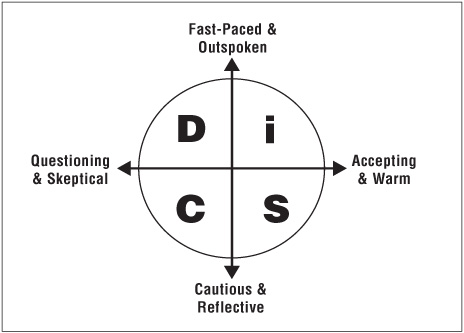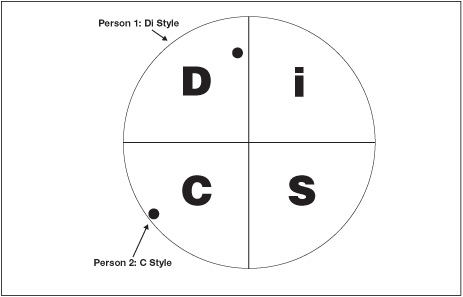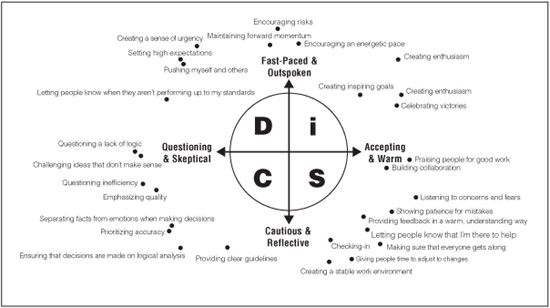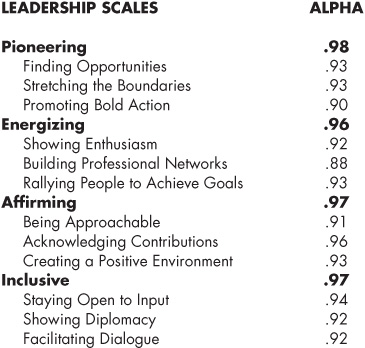Appendix
DiSC® Background, Theory, and Research
Although the DiSC® model was developed almost a century ago, DiSC research became much more focused and systematic in the 1970s. Since that time, the heart of the model has remained the same, but our current understanding of DiSC is far more advanced. Our third generation of DiSC reflects not only advancements in the general field of psychology, but also a forty-year program of research into the model. In this appendix, we want to give you a brief description of the core concepts behind DiSC and explain, both conceptually and empirically, how this theory was used to develop the 8 Dimensions of Leadership Model.
The Basics behind the DiSC Model
The Two DiSC Axes
There are two basic axes that serve as the foundation of DiSC. As you can see in Figure A.1, the horizontal and vertical axes create quadrants that are the D, i, S, and C styles. Understanding these two axes is the key to recognizing the relationships among the styles and applying the model in a real world setting. Chapter 2 describes how these play out in the domain of leadership. Here we will look at the axes from a more technical and historical perspective.
The vertical axis runs from fast-paced and outspoken to cautious and reflective. It describes one’s outward activity level and assertiveness. Traditionally, those at the northern end of the axis (i.e., the D and i styles) were described as “seeing themselves as more powerful than the environment.” As a consequence, they were more likely to be bold and project confidence. Those at the southern end of the axis (i.e., the S and C styles) were traditionally described as “seeing themselves as less powerful than the environment.” Therefore, they were more likely to adapt to current circumstances and work within existing parameters. At times, they have been referred to as “passive,” but the connotations of this label distract from the strengths that these two styles bring to an organization.
The horizontal axis has been the source of much more confusion over the years. After a full year of research on this specific issue, we concluded that this axis is best described as running from questioning and skeptical to accepting and warm. Those on the western side of the model (i.e., the D and C styles) were traditionally described as “perceiving the environment as antagonistic to their interests.” That is, they are more likely to view the world as resistant or unwelcoming to their needs. As a consequence, these people tend to be skeptical of new people or ideas, not always trusting information at face value. Our newest research suggests that people with a combined DC style frequently describe themselves as questioning or challenging.
Those on the eastern side of the model (i.e., the i and S styles) were traditionally described as “perceiving the environment as aligned with their interests.” That is, they trust their environment. New information or new people are likely to be accepted at face value. People with a combined iS style tend to describe themselves as cheerful, caring, and receptive.
It is worth noting that the horizontal axis of DiSC is sometimes described as being a task-oriented vs. people-oriented axis. Our research continually refutes this. We find that many people with the S style describe themselves as task-oriented and many people with the D style describe themselves as people-oriented. The task-people axis more correctly appears to run diagonally from the C style to the i style.
The Four Styles
The four quadrants of the DiSC map have been labeled Dominance, Influence, Steadiness (originally Submissiveness), and Conscientiousness (originally Compliance). The four styles are described as follows:
Dominance: describes people who are driven and forceful. They usually have strong opinions about how things should be done and are direct, if not blunt, with those opinions. They often describe themselves as aggressive, strong-willed, and demanding.
Influence: describes people who are enthusiastic and high-spirited. They’re quick to seek out new social opportunities and are generally very talkative. This style combines a high level of energy with a strong positive disposition.
Steadiness: describes people who are gentle and accommodating. They’re very considerate of other people’s needs and show a great deal of patience. They work to create an environment around them that is stable and harmonious.
Conscientiousness: describes people who are analytical and reserved. They place a high value on accuracy and take a systematic approach to their work. Emotional displays are kept to a minimum, as they put a strong emphasis on logic and reason.
DiSC as a Circumplex
The four DiSC styles are, in essence, a typology. They are categories that help us quickly understand individual differences. Although a person is often said to have one particular style, it is important to recognize that most people can stretch into all of these areas when the situational demands are pressing enough. In fact, the parsing of the model into four quadrants is, from a theoretical perspective, arbitrary. It could just as easily have been divided into eight sections or twelve sections (although four styles are much easier for the average person to remember than eight or twelve). The point is, the four styles should not be viewed as discrete, unrelated categories. We are all a blend of the four styles, but tend to favor some more than others.
When William Marston initially presented the DiSC model, he compared it to the color wheel in which each of the colors blends gently into adjacent colors. Our research confirms that this is a very apt analogy and that DiSC can accurately be described as a circumplex. As a technical designation, DiSC’s circumplex structure has a host of mathematical implications for the theory. But in lay terms, “circumplex” means that all areas of the DiSC model are equally valid and meaningful. One person may have a pure D style, while another person has a mostly D style with a slight leaning toward the C style. One style blends into an adjacent style much the same way red blends into orange. As we will see momentarily, this insight allows for some profound improvements in the measurement and application of the model.
The Measurement of DiSC
John Geier was one of the early researchers to build a formal measurement system to Marston’s concepts. His tool assigned scores to the test taker on each of the four styles and presented these scores in the form of a line graph. The styles were treated like separate domains, largely independent from each other. In the early 1970s, the DiSC model and instrument was first commercialized in the business community by Geier’s company, which later became Inscape Publishing.
Although research on the DiSC model persisted through the ’80s and ’90s, the presentation of DiSC as a pure typology remained the same. A second generation of DiSC measurement developed at Inscape by Pamela Cole and Gary Little took advantage of computerized assessment and offered test takers personalized narrative to accompany their D, i, S, and C scores. By the early 2000s, however, a deeper insight into both DiSC theory and psychometric theory allowed for a third generation of the model in which DiSC was measured as a circumplex. Not only is this conceptualizing of DiSC more consistent with Marston’s original writing, but it is also much more representative of developments in contemporary academic psychology (e.g., the interpersonal circle.)
Instead of measuring and presenting DiSC as four discrete scales, DiSC was measured as eight intercorrelated scales equally spaced around the DiSC circle. Not only were D, i, S, and C measured, but blends of the styles were also measured (i.e., Di, iS, SC, and CD). From these eight scales, an individual could be located on the two DiSC axes and then plotted within the DiSC circumplex, as shown in Figure A.2. Beyond being more conceptually accurate, this method of presenting results has a host of other advantages. For instance, two individuals could much more easily visualize their similarities and differences within the DiSC model. Or, a lone individual could more easily visualize the effort required to stretch from, let’s say, the C style to the i style.
Figure A.2. Example of DiSC circumplex results
The research was exceptionally supportive of this new method of measuring DiSC. New data continues to support both the validity and reliability of the assessment. For instance, scientists look at the “internal reliability” of a scale to assess if that scale is measuring a single unified concept. A metric called “Cronbach’s Alpha” is used to evaluate internal reliability. This metric ranges from 0 to 1 and is expected to be above .70 for a given scale before being considered acceptable. As shown in the diagonal of Table A.1, each of the DiSC scales well exceeds this value. Table A.1 also shows the intercorrelations among the DiSC scales. As expected under circumplex theory, adjacent scales (e.g., the S and Si scales) are most highly correlated and scales opposite each other on the DiSC model (e.g., the S and D scales) have a strong negative correlation.
Table A.1. DiSC Scales Intercorrelations and Reliabilities
The Application of the DiSC Circumplex
Although not necessarily called “DiSC,” the fundamental concepts behind DiSC are continually rediscovered by thinkers and researchers in a wide variety of disciplines. In academic psychology, the DiSC concepts are referred to as the “interpersonal circle.” In Ancient Greece, Hippocrates referred to them as the “four humours.” The reason that this model continues to pop up again and again is because DiSC addresses very fundamental aspects of human nature that have a profound impact on how we do our work and how we relate to each other.
DiSC is a general measure of personality, but it has long been applied to a variety of professional domains. An individual with a particular style is thought to have specific priorities on the job and gravitate toward certain job-relevant behaviors. Before expanding the DiSC circumplex into the field of leadership, we began researching two professional fields that have long used the DiSC model to help develop workers: management and sales.
We expected that tasks and attitudes of managers and salespeople would take a shape that closely resembled the DiSC circumplex. For example, we asked managers what is important to them on the job and were able to plot out their preferences in two-dimensional space using a technique called multidimensional scaling. What we found was that the managers’ attitudes conformed quite remarkably to the basic DiSC model. Take a look at Figure A.3. Each dot represents a management priority, and the closer two dots are to one another, the more similar they are. So, managers who cared about “creating a sense of urgency” were also likely to care about “setting high expectations,” but less likely to care about “providing feedback in a warm, understanding way.” It’s easy to see how management priorities clearly reflect the DiSC circumplex.
Figure A.3. Multidimensional plotting of management priorities
We conducted similar studies in the area of sales. In one such study, salespeople were presented with fourteen sales tasks relating to customer interactions and asked to rate how important each was when they were interacting with clients. The results, as shown in Figure A.4, clearly show the relevance of the DiSC model. For example, the tasks in the upper left-hand corner reflect a results orientation, which is typical of the D style, and the task in the lower left-hand corner reflect a priority on quality and evidence, which is typical of the C style.
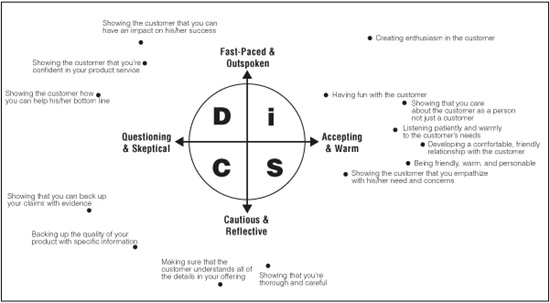
Figure A.4. Multidimensional plotting of sales tasks
This research supports what DiSC practitioners have been teaching for years: DiSC, as a measure of personality, helps explain how people approach their jobs in a variety of different professional fields.
The Application of DiSC to Leadership
We began our investigation by reviewing the work of contemporary and traditional thought leaders in the leadership arena. Additionally, we reviewed academic research in the field to help differentiate between the supported and unsupported theories and assertions. We found that DiSC had a great deal to say about the interpersonal concepts that were being discussed by thought leaders such as Jack Zenger, Peter Drucker, John Kotter, Jim Kouzes and Barry Posner, Sun Tzu, Jack Welch, Robert Greenleaf, Warren Bennis, Edgar Schein, Stephen Covey, Larry Bossidy and Ram Charan, Daniel Goleman, Peter Senge, and Jim Collins.
After identifying the leadership constructs that were relevant to the DiSC model, we began the data collection stage of the project. In twelve rounds of data collection, 26,899 participants were asked questions about their own leadership performances as well as the performances of leaders in their previous or current organizations. These data were used to identify and build initial leadership scales and understand the psychometric relationships among various leadership constructs.
Next, leaders were chosen from a wide range of industries. For these leaders, managers, peers, direct reports, and other colleagues were selected to rate the leaders’ performance on the initial leadership scales. Leaders were also asked to rate their own performance. Based on these results, the leadership scales were refined. More importantly, however, we began to see the emergence of a very clear leadership model that explained the relationship among these leadership constructs. This, of course, was to become the 8 Dimensions of Leadership Model.
After this model development stage, we conducted research with over 3000 additional raters to confirm the validity of this model. These studies confirmed both the ability to measure the proposed leadership constructs and the robustness of the leadership model. If you look at Table A.2, you can see the eight dimension scales, along with three subscales that fall under each. The Alpha values in the second column suggest exceptional reliability for each of these scales.
Additionally, the correlations among the scales offered strong support for the 8 Dimensions of Leadership Model. Figure A.5 offers a visual representation of the relationships among the scales using multidimensional scaling (MDS). (Keep in mind that the original MDS rotation is presented and this rotation is arbitrary.) Although the eight scales do not form a perfectly equidistant circle (as predicted by the model), this theoretical ideal is nearly impossible to obtain with actual data. The actual distance between the scales, however, is roughly equal, providing strong support for the model and the assessment of that model. Figure A.6 allows for a visual inspection of the relationships among the DiSC Leadership subscales, which are also arranged in a clear circular pattern.
We were also curious about overall effectiveness. That is, are some of the dimensions of leadership more important than others? Generally speaking, we found that the importance of a leadership dimension often depended on how “effective leadership” was being defined. For example, when we asked which leaders were most respected in their organizations, the Energizing and Deliberate Dimensions seemed to have the most influence. When we asked about the leaders people most enjoyed working with, the Affirming and Inclusive Dimensions had the biggest influence. Overall, however, all of the dimensions had very strong relationships with perceived effectiveness. The lowest correlation with being rated as a good leader was .57 (Humble) and the highest was .72 (Energizing). These correlations support the conclusion that each of the eight dimensions plays an important role in successful leadership.
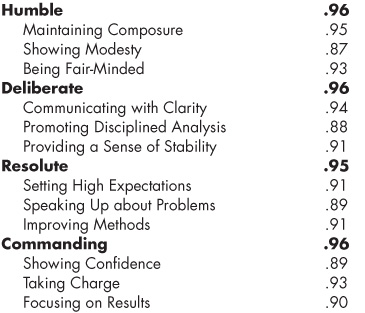
Table A.2. Leadership Scale Reliabilities
Figure A.5. MDS Analyisis for the DiSC Leadership Scales (The original MDS rotation is presented here. This rotation is arbitrary.)
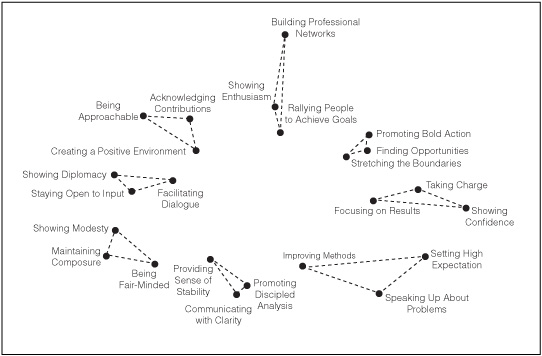
Figure A.6. MDS Analyisis for the DiSC Leadership Subscales
As part of our research, we also asked people what they wanted their leaders to do more of. We expected to see a wide range of responses. That is, because leaders are different, with different DiSC styles, we expected that people would ask their leaders for a variety of changes. This is exactly what we found. For instance, people with the D (Commanding) style were most often asked to acknowledge the contributions of others. People with the i (Energizing) style were most often asked to improve methods and processes that their teams use. People with the S (Inclusive) style were most often asked to find more opportunities for their teams. People with the C (Deliberate) style were most often asked to rally the team to achieve their goals.
One of the biggest surprises came as we were conducting the qualitative portion of our research. As part of the study, we interviewed seasoned leaders with different DiSC styles about their experiences and growth as leaders. We expected that leaders would identify their biggest challenges and blind spots as those dimensions that were across the circle from them on the 8 Dimensions of Leadership Model. For instance, we expected that a Resolute leader would identify the Affirming Dimension as the one in which she needed the most growth. Well, that’s not what we always found. Although the Resolute leader sometimes saw the need to be more Affirming, many times the leader chose Pioneering or Humble instead. There was some predictability, but it wasn’t as high as we expected.
In response to this finding, we had to adjust the way we designed this book. Our original intention was to recommend that leaders work on developing the one, two, or three dimensions that are opposite them on the model. We realize now, however, just how large a role situational factors play in a leader’s development. For instance, one of the leaders in our study was very Resolute in his outlook, but he felt the strongest need to work on the Commanding Dimension. Why choose a dimension that was so close to his default setting? Well, he was a young leader in a very hard-charging environment. His first need was to gain credibility and show strength. Similarly, we found that many of the people we talked to had unique situations that called for leadership dimensions that couldn’t be predicted by a model.
For this reason, we developed the short survey that you can find at the beginning of Part 3. This is the 8 Dimensions of Leadership Needs Assessment, with questions that have been adapted from our 360° assessment tool. Ultimately, our research has helped us to clarify the interpersonal domain of leadership and, hopefully, helped you get your head around the intimidating diversity of leadership responsibilities. And perhaps more importantly, our qualitative research has led us to conclude that one of the best predictors of leadership growth is, in fact, the desire to grow.

